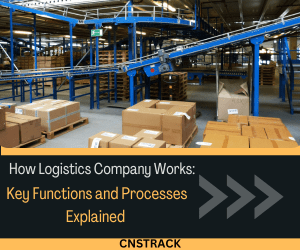How logistics company works: Logistics companies play a pivotal role in managing the supply chain of businesses, encompassing tasks from supply procurement to distribution. Understanding their functions is essential for ensuring smooth operations. Let’s delve into the core functions of a logistics company:
How a Logistics Company Works: The core functions of a logistics company
1. Efficient Order Processing:
- Order processing marks the beginning of logistics activities.
- The commercial department verifies order terms before processing.
- Deviations from agreed terms are identified and resolved.
- Pricing, payment methods, and delivery schedules are confirmed.
- Material availability is checked, and production planning is initiated if needed.
- Accurate order processing ensures a strong foundation for the supply chain.
2. Strategic Materials Handling:
- Materials handling involves moving goods within warehouses.
- Efficient management of inventory for quick and accurate order fulfillment.
- Proper organization minimizes search time and maximizes efficiency.
- Precision in materials handling ensures timely deliveries and reduces errors.
- Large warehouses require systematic management to avoid disruptions.
3. Significance of Warehousing:
- Warehousing strategically places inventory for efficient distribution.
- Proximity to customers reduces transit time and enhances customer satisfaction.
- Distribution centers and warehouses facilitate timely order fulfillment.
- Warehouses act as intermediaries between manufacturers and end customers.
- Proper warehousing helps manage fluctuations in demand effectively.
4. Balancing Inventory Management:
- Inventory management is critical for meeting customer demands.
- Balancing adequate stock levels with cost-effective inventory management.
- Inventory management software streamlines tracking and optimization.
- Avoiding overstocking and stockouts ensures efficient operations.
- Accurate inventory data enhances decision-making and resource allocation.
5. Resource-Intensive Transportation:
- Transportation is a key logistical activity, often driven by fuel costs.
- Managing Less Than Truckload (LTL) and Full Truckload (FTL) shipments.
- Physical movement of products from manufacturers to customers.
- Cost control and efficiency are vital due to the high expenses involved.
- Timely deliveries depend on optimized transportation routes and methods.
6. Effective Packaging Solutions:
- Packaging serves both aesthetic and functional purposes.
- Attractive shelf packaging influences customer purchasing decisions.
- Transport packaging prevents damage during transit.
- Insufficient packaging can lead to losses and damage claims.
- Proper packaging minimizes the risk of product deterioration.
7. Continuous Monitoring for Efficiency:
- Constant monitoring of inventory, transportation, and warehousing.
- Real-time data aids decision-making and proactive problem-solving.
- Monitoring enhances resource allocation and cost management.
- Efficiency improvements through data-driven insights and adjustments.
Enhancing Customer Experience through Logistics
- Effective logistics positively impacts customer satisfaction.
- Timely deliveries, reduced costs, and faster order processing.
- Smooth logistics contribute to brand reputation and customer loyalty.
The Role of Logistics Companies in a Connected World
Defining Logistics in a Changing Landscape
A logistics company serves as the orchestrator of the complex processes involved in moving goods, spanning from warehousing to transportation, from point of origin to consumption, all while aligning with specific customer requirements. In the wake of the COVID-19 pandemic, the significance of logistics has surged as these companies continue to ensure timely deliveries even in the face of challenges and disruptions.
Strategies and Execution of Logistics
The logistics landscape involves a symphony of activities, from transportation to packaging, inventory management to warehousing. These functions work in tandem, resembling a relay team that passes the baton of coordination seamlessly.
Multifaceted Functions within Logistics
- Order Processing: Logistics management systems handle incoming orders, ensuring accuracy and compliance.
- Warehousing: Goods are stored strategically in warehouses, facilitating efficient distribution.
- Packaging: Secure and labeled packaging safeguards goods for transit.
- Transportation: Vehicles are inspected and optimized for safe deliveries.
- Tracking and Scanning: Orders receive tracking IDs for efficient monitoring.
- Technology Integration: Real-time monitoring, route optimization, IoT, and robotics enhance efficiency.
Selecting the Right Logistics Service Provider
Due to the complexity, businesses often outsource logistics specialists. Different models include:
- Freight Brokers: Act as intermediaries between suppliers and carriers, offering diverse shipment options.
- Freight Companies: Transport goods through various modes, adapting to specific needs.
- Freight Forwarders: Tailor transport solutions using established networks for cost and time savings.
- Carriers: Directly handle freight via rail, trucking, air cargo, and ocean transport.
- 3PL Companies: Offer end-to-end supply chain management, including warehousing, transportation, and more.
Logistics in a Connected World
- The global logistics market reached nearly USD 9,525.1 billion in 2021, projected to grow at a CAGR of 5.7% to reach about USD 13,326.3 billion by 2027.
- Technological interventions are transforming logistics, enhancing efficiency, and adaptability.
- Real-time monitoring systems with AI and ML enable precise tracking of shipments.
- Route management systems optimize shipping routes, cutting costs and labor.
- IoT-based solutions bridge supply and demand gaps through better visibility.
- Robotics and automation streamline warehouse operations and heavy lifting.
Driving Operational Efficiencies through Logistics
Logistics plays a pivotal role in driving operational efficiencies across industries. By efficiently managing raw materials, inventory, and fulfillment strategies, companies reduce costs and maintain competitiveness. Technology solutions further empower logistics, shaping new business models and expanding market opportunities.
In a world that grows increasingly interconnected, the role of logistics companies has never been more crucial. Their ability to adapt to challenges, integrate technology, and ensure seamless movement of goods fuels economies and keeps businesses thriving.
Common Questions About Logistics
- What are the 7 steps of logistics?
- The 7 steps encompass order processing, materials handling, warehousing, inventory management, transportation, packaging, and monitoring.
- What are the 4 major logistic functions?
- The major functions include order processing, materials handling, warehousing, and transportation.
- What is the basic process of logistics?
- The basic process involves receiving orders, managing inventory, moving goods, and delivering them to customers.
- What is the main work in logistics?
- The main work involves orchestrating the movement of goods, optimizing supply chains, and ensuring timely and cost-effective deliveries.
